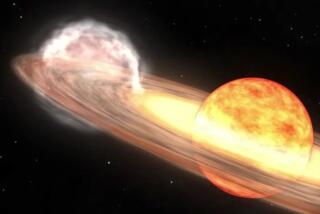Solar activity causes particle storm, delays rocket launch
Massive sunspot AR 1944 is getting feisty, and doing some damage.
Several Earth-lengths across, it is one of the largest sunspots seen in a decade. It is also complex, with dozens of dark cores.
“Sometimes you see a nice, big simple brown sunspot, and even though it’s big, it’s boring,” said Alex Young of NASA’s Goddard Space Flight Center. “But as soon as they start getting twisted and breaking apart and merging with each other, you know something exciting is going to happen.”
And something exciting has happened. Tuesday afternoon, AR 1944 was the source of a powerful X-class solar flare accompanied by a coronal mass ejection, which sent perhaps billions of tons of solar material hurtling toward Earth at nearly 1,500 miles per second, said Young.
At the same time, the edges of the mass ejection cloud created a shock wave strong enough to accelerate tiny particles in the solar atmosphere to almost the speed of light. The result is what is known as a particle storm. (Check out video here.)
We will not feel the effects of the particle storm, or the mass ejection, here on Earth (thank you, atmosphere). However, the extra radiation the particle storm caused in space had engineers from Orbital Sciences Corp. concerned enough that they delayed the launch of a rocket scheduled to carry supplies to the International Space Station.
They have rescheduled the launch for Thursday at 10:07 a.m. PST.
In the meantime, AR 1944 will continue to face Earth for another week or so, and forecasters at the National Oceanic and Atmospheric Administration’s Space Weather Prediction Center say it is well positioned to deliver more storm activity in the next several days.
All this is good news for aurora watchers because coronal mass ejections often result in electromagnetic storms. According to NOAA’s Facebook page, the auroras are expected to be especially starting Thursday just after midnight and may be visible as far south as the mid-United States.
Follow me on Twitter for more like this!
ALSO:
Scientists experiment with money laundering
The secret neon world of biofluorescent fish, revealed [Photos]
Hubble harnesses gravity to find dim, ancient galaxies near big bang






